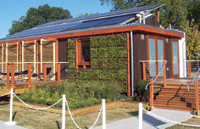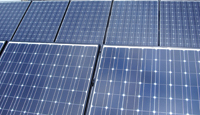
Going green with sunshine
Renewables and Ontario’s new Green Energy Act – do your homework to separate the facts from any misconceptions
The media messaging on energy is that we all should do our part to conserve and employ any means possible to incorporate renewables into mainstream usage. It’s not hard to get agreement on that point, but business owners cannot overlook the fact that whatever they do also has to make sense economically. The commodity market volatility in the last few years, where crude oil pricing rose to highs of over $140 US/barrel, along with the push by environmental groups and society in general to do more to protect our planet, have influenced all levels of government to respond.
 |
| Ag Energy’s offices in Guelph, Ontario; the co-operative is an industry pioneer in utilizing solar panels. |
In Ontario, the Green Energy Act, which was passed on May 14, is a prime example of governmental response. Depending on which group you talk to, there are pros and cons to be addressed. The Act allows the provincial government to oversee land use planning, including setbacks. The Act also prioritizes the application process at the utility and government levels and removes some of the procedures and bylaws that may have delayed potential green energy producers. The overall intent is to speed up the rate at which renewable projects are put into service.
The act spurred interest in small solar projects
The part of the Act that attracted a great deal of attention was the proposed Feed-in Tariffs and particularly the near doubling of the amount paid for small solar installations. And here’s where the hype comes in. All of a sudden, there seems to be an explosion of companies selling solar, some established companies expanding in anticipation of increased demand and some with no experience behind them whatsoever hoping to capitalize on new markets.
 |
| A pole-mounted solar panel unit. |
 |
| Ag Energy staff take a closer look at the co-operative’s solar panels. |
 |
| Solar panels are key components of many small environmental projects. |
 |
| Solar panels up close. |
This brings us to a common theme we continue to reiterate, namely – do your homework and look before you leap. The feed-in tariffs are certainly attractive but don’t forget that estimated payback periods are usually based on the best case scenario which may or may not be applicable to your individual situation. Solar offerings, for example, vary from turnkey installations, on an own or lease basis, to supplying the materials for do-it-yourself projects. Please keep in mind that even though application processes may become streamlined, they still exist and must be handled properly.
Many rebates contingent on prior construction approval
Due to individual situations, the timeline varies for a start to finish solar project. However, you can be sure there will be a capital outlay required on your part, long before the sun hits your panels. As well, many of the available rebates are contingent upon approval being obtained prior to the start of construction. So once again, we stress, do your homework.
Some 970 trillion kilowatt-hours of energy comes from the skies every single day, so it only makes sense to try to harness this bounty. The two main applications for solar energy are to generate electricity and to heat water.
The importance of the noon-day sun
Solar Photovoltaic (PV) installations generate electricity for your own use or may be connected to the grid in some jurisdictions. The greatest amount of electricity is produced approximately one hour before and after solar noon, which is the time of day when the sun is at its highest, and therefore, has the greatest intensity. Typically, panels are installed on south-facing roofs, ground or pole mounted and can be fixed or tracking. Solar panel nameplate rating comes from testing at 25 degrees Celsius with a solar irradiance input of 1,000 Watts/m2; however, the actual energy produced is usually 70 per cent of the nameplate value because of non-ideal atmospheric conditions.
Solar Thermal, on the other hand, is used to heat water and therefore does not connect to the grid but rather provides hot water for your own use. The systems usually require food grade antifreeze to prevent freezing at exterior temperatures below 0°C and hot water storage tanks are typically kept at 60°C to prevent bacteria growth. For a constant temperature supply of hot water, a heat storage unit should have at least one gallon of storage for each square foot of collector area.
We have only scratched the surface of what you need to know before installing any solar or renewable system, but hopefully have inspired you to find out more and do your part to contribute to a greener society. ■
In the next issue we will switch gears a little and discuss retail markets for natural gas and electricity. We’ll guide you through the offers that cross your door and offer some resources to help you with decision-making.
Chris Hanlon is the Director of Energy Services for Ag Energy Co-operative and is an engineer with over 25 years’ energy management experience. He can be contacted at chanlon@agenergyservices.ca.
Print this page